Greek culture is a silent narrative that offers us a look into the wonderful lives, stories, and traditions associated with our long-gone ancestors. It is more than just old-time artwork. Greek culture, which developed thousands of years ago still attracts and inspires us now. The Greeks used pottery as a canvas on which to tell stories about their gods, heroes, and everyday lives.
From the elegant black-figure to the intricate red-figure techniques, ancient Greek pottery captivates with its intricate designs and mythical narratives. With the help of this informative reference to ancient Greek pottery, we’re going to take you back in time.
Ancient Greek Pottery – A Timeline
These were social evidence that conveyed cultural values, told myths and stories, and documented significant historical events; they were more than just useful tools. Then followed the Golden Era of the Classical Period, when the shadows of black-figure pottery gave rise to red-figure pottery. This historical period saw an increasing turn towards reality while maintaining its dependence on mythological stories.
The First Discovered Pieces
Greek pottery took its initial steps towards distinction with the emergence of the Proto-Geometric style around 900 BCE. Following this, around 800 BCE, the Geometric style of Greek pottery made its debut, marking a significant evolution in craftsmanship and artistic expression. Greece’s eastern border along the Aegean Sea today presents a striking image of golden sandy beaches and beautiful azure waters increasing regional views.
Asia, with its wealthy and advanced cultures that had developed this skill thousands of years ago, is thought to be the birthplace of the oldest ceramic works of art. Its diverse landscapes and vibrant civilizations provided fertile ground for the evolution of pottery, shaping the course of human history and artistic expression.
Attic clay, cherished for its exceptional quality and rich iron content, holds a special place in the world of pottery. Originating from the region of Attica in ancient Greece, this distinctive clay has been prized for centuries for its unique properties. Its deep reddish hue adds warmth and character to pottery creations, infusing them with a timeless appeal.
Introducing Geometric Decorations
Greece’s Bronze Age was a time of great artistic achievement and inventiveness, especially in the field of pottery making. The Peloponnese region became an expert in ceramic handmade goods due to the widespread recognition of its unique Sesklo products, which are known for their complex patterns and innovative fire processes.

Innovations like the potter’s wheel emerged during this time, improving the process of making pottery and opening the door for higher-quality and creative designs. Stories of battle and conquest are frequently connected to ancient history, it’s vital to remember that incredible advancements in art and technology also occurred during this time.
A Setback – The Dark Ages
The conquest that began the Greek Dark Ages was a major damage to Greece’s lively and broad society. Greece suffered greatly as a result of the Dorians’ invasion, especially in cities like Athens where Greek art and architecture were badly damaged.
Artistic innovation and originality experienced an extreme decline during this time, as many masterpieces were destroyed or lost. The complex art forms that had arisen in Greece before the conquest were mostly destroyed as a result of the conquering Dorians establishing their own cultural norms. This is the way outside forces can interfere with and slow down the growth of a culture.
A Defining Style in Greek Pottery – The Post-Dark Age Years
Greek civilization experienced the rise of the geometric style, a unique and much-appreciated type of decorating characterized by its simplicity and accuracy. It was different from the more complex Mycenaean art in that it valued symmetrical patterns, repeating shapes, and clean lines that gave off an air of harmony and order.
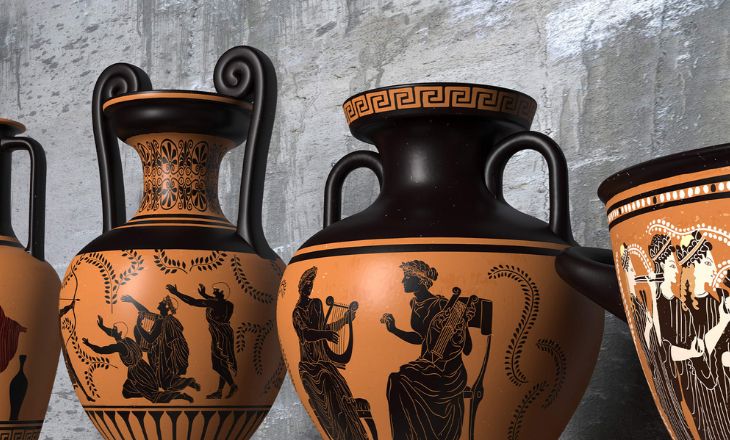
The geometric style was attractive because it could represent complicated concepts in patterns that appeared to be simple. The Greeks’ long-lasting influence in geometry and mathematics was also established by the geometric style’s dedication to mathematical accuracy, which reflected their respect for reason and logic.
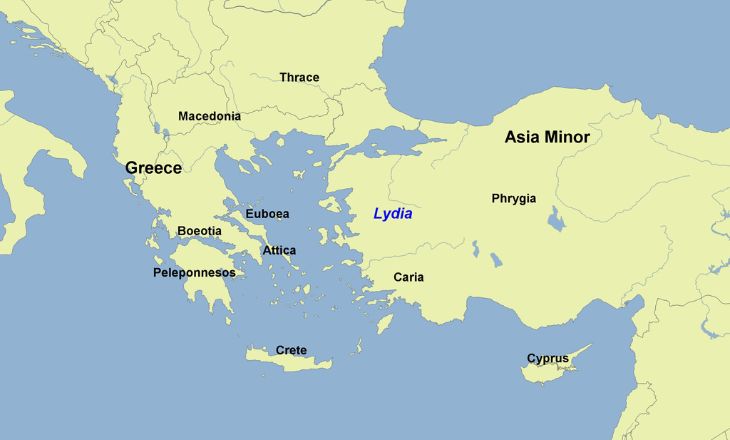
Greece and Asia Minor
Oriental Style drew its inspiration from Eastern customs and cultures which was a significant progress. This change expanded the scope and increased the variety of Western art by introducing fresh color schemes, themes, and techniques. A growing love for Eastern aesthetics was created by the introduction of elements like calligraphy, nature symbolism, and asymmetry, which introduced an exotic charm that captivated viewers.
What Technology Did the Greek Potters Have?
Greek potters were artists and technologists of the highest level. The diversity of Greek pottery designs showcases the creativity and skill of ancient artisans. Their limited hands expertly worked with clay, they shaped the basis of today’s world through ceramics. The utilization of hand-building pottery techniques showed how these artists could skillfully work clay into a range of applications without the heavy reliance on technology that is so common in modern society.
These methods mostly consisted of coil construction, which involves picking out long clay strands and putting them to create a structure, squeezing pots, physically molding the clay with the fingers, and slab-building, which involves joining flat clay pieces together. The fact that they used highly advanced pottery wheels that were years ahead of their time was another amazing technological achievement.
Greek Pottery Types and Styles
Greek ceramics isn’t complete without admiring the wonderful handiwork of amphoras, which are tall, two-handled containers that are mostly used to carry priceless goods like wine and oil. Greek potters have used this form as a highly useful canvas because of its large body, which is frequently covered in finely detailed subjects from mythology or daily life.
Geometric Pottery
Discovering the world of geometric ceramics shows the grace and color scheme of classical Greek design. It takes its name from the geometric patterns that are used throughout the design, which are circles, triangles, and zigzags linked together with story illustrations. Every piece is more than just an eye-catching object; it reveals an arrangement of cultural elements and Greek mythology.
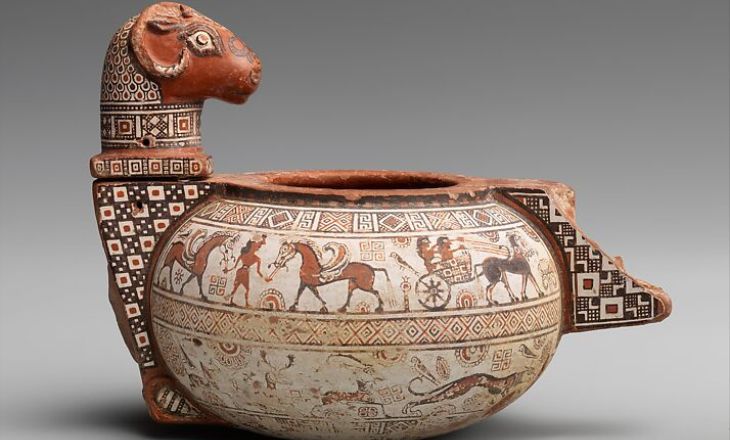
Terracotta oinochoe
There are several forms used in geometric pottery, such as kraters for combining wine and water, pyxis for personal storage, and amphorae for storing oils or wines. It’s interesting to note that these art pieces were more than just decorations; they promoted mythological and real-world events, which is a wonderful example of how both practical and artistic needs can coexist.
Corinthian Pottery
Corinthian ceramics represent the creativity and artistic spirit of the Greeks. Greek ceramics of this particular style stand out from the others due to their excellent quality and complex patterns.
But Corinthian ceramics offer more than just beauty; they also provide light on the way of life of the ancient Greeks. The larger items, such as loutrophoros (used during wedding rituals), clue at society norms and conventions, while the smaller pieces, such as aryballoi (a small spherical or globular flask), might teach us about personal grooming habits and fragrance techniques in ancient times.
Black-figure pottery
Greek black-figure pottery was created with such skill that it not only clearly shows generations of highly skilled handiwork but also gives the myths and stories written on each piece of life. This strong style, which originated mostly in Corinth, quickly spread throughout the Aegean.
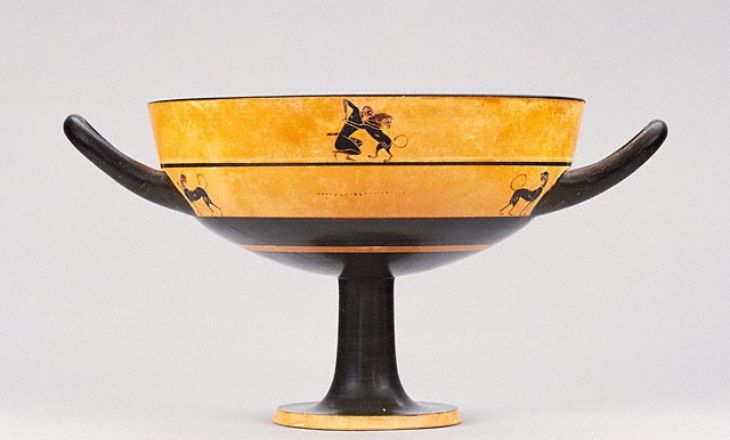
Black-Figure Pottery
Natural clay is burnt at high temperatures with iron-rich slip, turning it shiny black. This unique process produces figures that decorate light-colored backgrounds. These remarkably eye-catching contrasts are what give Black-figure ceramics its name. Each development in Black-figure ceramics is still a symbolic story to be studied and enjoyed.
Red-Figure Pottery
Red-figure pottery, which bravely broke out from its ancestor, black-figure pottery, is a fascinating form that reveals the captivating artistry of Ancient Greece. Red-figure pottery has engaging beauty and fashion; it is shiny and full of decorative forms that honor humanity and refinement. It gives Greek vases‘ stylistic commitment a dynamic appeal with its red-painted figures set against a black backdrop.
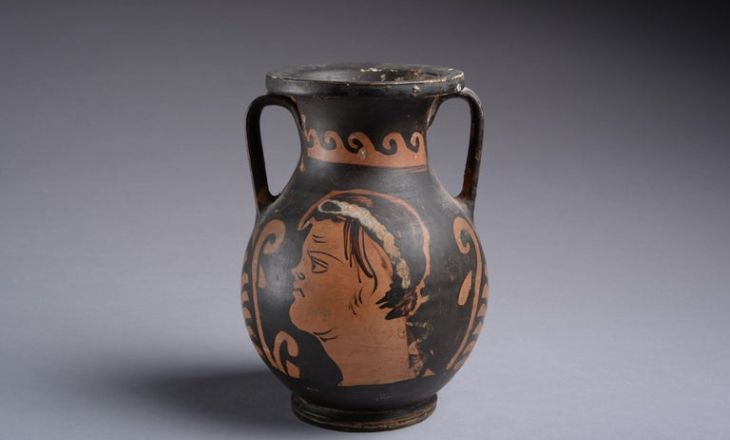
Red-Figure Pottery
The delicate balancing act between art and utility is what gives Red-figure ceramics its complex beauty. Therefore, the next time you admire a piece of Red-figure pottery, keep in mind that, despite their superb design, the vessels were everyday items that fulfilled necessities rather than just being artifacts!
Traditional Ancient Greek Pottery Shapes
From the geometric contours of amphorae used for transporting oil and wine; to the slender stem and smooth round body of the lekythos used for storing perfumes – each pottery shape boasts tales steeped in history, culture, and elaborate historical significance. Ancient Greece pottery reflects the artistic ingenuity and cultural richness of the civilization through its intricate designs and innovative techniques.
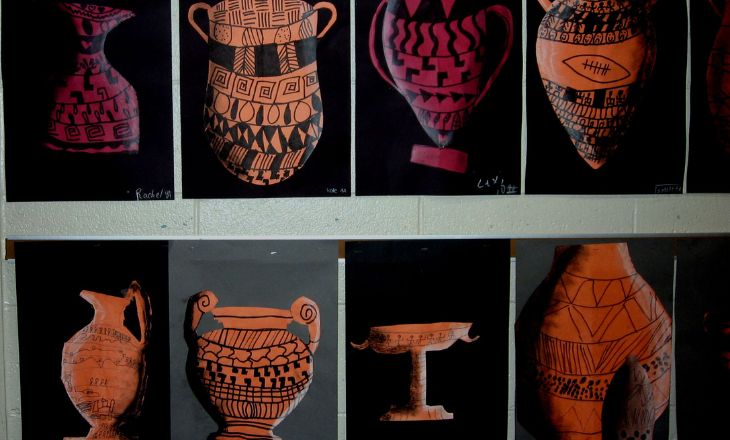
| Name | Style | Use |
| Alabastron | Long neck. sufficiently small to fit in a single hand. | scented lotions and fragrances. |
| Amphora | Jar with two handles. usually has a narrow neck and is tall. | Food and drink containers. used occasionally to contain the deceased’s ashes. |
| Aryballos | little spherical container with a large openness and a small neck. | scented treatments and fragrances. |
| Hydria | Jar with three handles: one in the back and two on the sides. a tall, wide body with a narrow neck to facilitate pouring. | most frequently used to serve and hold water. |
| Krater | A broad appearance and a big, lip-licking mouth. Usually, the body narrows near the base. | using water to dilute wine. |
| Lekythos | Just one handle. a spherical body with a long neck that opens into a large mouth. | keeps oil on hand for ceremonial occasions like weddings and funerals. |
| Loutrophoros | two-handed. a spherical body with a long neck that opens into a large mouth. | holds water in reserve for special occasions like weddings and funerals. |
| Oinochoe | A single handle that curled. Round body transfers from a small base. The lip of the mouth is one-sided, like a pitcher. | a pitcher of wine. |
| Olpe | Like an Oinochoe but with a cylindrical, thinner body. | A wine pitcher. |
| Pelike | a vessel with two handles but no neck. usually having a large mouth and a rounded body. | Liquid serving and storage. |
| Psykter | A bulbous body with a small base. | used to chill wine by putting it in ice or cold water. |
| Pyxis | a top-hatched, cylindrical shape. There is a pointed handle on top. | jewelry case. |
| Stamnos | a vessel with two handles but no neck. usually having a broad mouth, a lid, and a circular body. | keeping liquids in storage. |
Conclusion
Greek pottery, with its characteristic red and black figure techniques, geometric patterns, and unusual vessel shapes, is proof of the classical period’s artistic ability. The history of pottery has been greatly influenced by these methods and designs, which have also improved our knowledge of Greek civilization and culture.
From the early experiments with clay in the Proto-Geometric era to the refined artistry of the Classical period, Greek pottery reflects a journey of artistic evolution and innovation.
FAQs
What is Greek Pottery Known For?
Greek pottery is renowned for its intricate designs, often depicting mythological narratives and scenes from daily life, and for its distinctive red and black-figure painting techniques, which flourished during the Archaic and Classical periods.
What Was the First Style of Greek Pottery Called?
The first style of Greek pottery is known as the Proto-Geometric style. Proto-geometric pottery is characterized by simple, geometric designs, often consisting of horizontal bands, zigzags, and triangles. Vessels produced in this style were primarily used for practical purposes such as storage and transportation.
What Material Was Most Greek Pottery Made From?
The primary material used for crafting Greek pottery was terracotta, a type of clay known for its reddish-brown color when fired. Terracotta provided potters with a versatile medium for shaping vessels of various sizes and forms, ranging from small cups and bowls to large amphorae and kraters.
